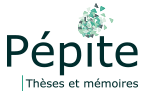Conception et réalisation de photodétecteurs X-UV à base de matériaux à large bande interdite destinés à des applications spatiales
Design and fabrication of X-UV photodetectors based on wide band gap semiconductors for space applications
- Nitrure de bore
- Détecteurs de rayonnement ultraviolet
- Semiconducteurs à large bande interdite
- Sondes spatiales
- Photodiodes
- Nitrure d'aluminium
- Langue : Français
- Discipline : Micro et Nanotechnologies, Acoustique et Télécommunication
- Identifiant : 2009LIL10095
- Type de thèse : Doctorat
- Date de soutenance : 18/12/2009
Résumé en langue originale
Les photodétecteurs ultraviolets actuels à base de silicium montrent des limitations inhérentes à la technologie en dépit de leur continuelle amélioration depuis ces dernières décennies. En collaboration avec l’Observatoire Royal de Belgique dans le cadre du projet LYRA (et BOLD), nous avons démontré la maturité des semiconducteurs à large bande interdite pour des applications dans les domaines spatiale et physique des hautes énergies. La disponibilité de ces nouveaux matériaux permet de surpasser les technologies existantes. En effet, de part leurs propriétés physiques et chimiques exceptionnelles, le diamant par exemple, est un des candidats idéal. Sa large bande interdite le rend insensible à la lumière visible et infrarouge (solarblind) et son excellente robustesse face aux radiations rend ce matériau très attractif pour des applications spatiales. Parallèlement à ce matériau, de nouveaux semiconducteurs nitrures à large bande interdite (AlN, BN) présentent des propriétés tout aussi remarquables et commencent à être élaborés avec succès. Le but de ce travail a été de concevoir et de fabriquer de nouveaux photodétecteurs UV innovants à base de ces matériaux. Cette activité a débuté par la simulation des propriétés de transports des matériaux à structure wurtzite par des modèles de types Monte Carlo, puis d’optimiser les performances des composants à élaborer par éléments finis au moyen du logiciel COMSOL® en tenant compte du matériau, de la géométrie de la structure, du design technologique, de la nature des électrodes (taille, contacts ohmiques, Schottky…), du couplage électro-thermique dans certain cas ainsi que des radiations incidentes. Différents capteurs UV ont ensuite été élaborés en salle blanche puis caractérisés sous rayonnement X-EUV d’une part et DUV-UV d’autre part. Les caractéristiques optoélectroniques (stabilité, fiabilité, sensibilité aux rayonnements UV, courant d'obscurité…) et les performances obtenues sont alors exposées pour chacun des matériaux étudiés. L’ensemble de ce travail a permis d’établir plusieurs performances à l’état de l’art sur diamant, AlN et BN et a contribué au développement du premier radiomètre solaire LYRA dans le domaine EUV au moyen de ces photodiodes diamant destinés au satellite PROBA2.
Résumé traduit
Currently, ultraviolet photodetectors based on silicon have shown limitations inherent to their technology in spite of their continual improvement for these last years. In collaboration with the Royal Observatory of Belgium within the LYRA (and BOLD) project, the maturity of the semiconductors with wide band gap is shown for specific applications in the space field and high-energy physics. The availability of these new materials makes it possible to exceed existing technologies. These materials present robustness, a radiation hardness and their wide band gap provide insensibility to visible and infrared lights. Indeed, because of their exceptional physical and chemical properties, diamond for example, is one of the ideal candidates from the point of view of fundamental research and technological applications. Furthermore, new nitrides semiconductors with wide band gap (AlN, BN) are now elaborated successfully and present remarkable properties such as diamond.The goal of this work was to design and to fabricate new UV photodetectors based on these materials. This work begins with determination of the transport properties of these semiconductors materials versus temperature by Monte Carlo simulation in order to optimize the performances of the photodetectors by means of a finite elements software based on COMSOL® by taking into account the material type, the geometry of the structure, the technological design, the nature of the electrodes (size, ohmic contacts, Schottky contacts, symmetry…) as well as incidental radiations. A physical-thermal coupling is implemented in some cases to determine the impact of thermal effects in device working behaviour. Various UV detectors are elaborated in clean room and characterized under X-EUV radiation on the one hand and DUV-UV on the other hand. The characteristics (stability, reliability, sensitivity to the radiations UV, dark current…) and the obtained performances are then described for each studied material. This work made it possible to establish several state of the art performances on diamond, AlN and BN and contributed to the development of the first solar EUV radiometer LYRA onboard PROBA2 satellite.
- Directeur(s) de thèse : De Jaeger, Jean-Claude - Soltani, Ali
AUTEUR
- Barkad, Hassan Ali


